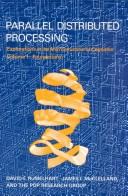| Listing 1 - 3 of 3 |
Sort by
|

ISBN: 0262181231 0262631121 0262181207 026268053X 0262132184 9780262181204 9780262132183 9780262181235 0262291401 0262291266 9780262291408 9780262291262 9780262631105 Year: 1986 Publisher: Cambridge (Mass.): MIT Press,
Abstract | Keywords | Export | Availability | Bookmark
 Loading...
Loading...Choose an application
- Reference Manager
- EndNote
- RefWorks (Direct export to RefWorks)
LAN (local area network) --- Computer. Automation --- hardware --- Cognitie. --- Computer programming --- Ordinateurs --- Programmation --- Human information processing --- Cognition --- Mental Processes. --- Information, Traitement de l', chez l'homme --- Cognitive psychology --- Artificial intelligence. Robotics. Simulation. Graphics --- #TELE:SISTA --- Human information processing. --- Cognition. --- #KVHA:Psycholinguistiek --- 681.3*C12 --- 681.3*I20 --- 681.3*I20 Artificial intelligence (AI) in general; cognitive simulation; philosophical foundations --- Artificial intelligence (AI) in general; cognitive simulation; philosophical foundations --- Information processing, Human --- Bionics --- Information theory in psychology --- Perception --- 681.3*C12 Multiple data stream architectures (multiprocessors): MIMD; SIMD; pipeline and parallel processors; array-, vector-, associative processors; interconnection architectures: common bus, multiport memory, crossbar switch --- Multiple data stream architectures (multiprocessors): MIMD; SIMD; pipeline and parallel processors; array-, vector-, associative processors; interconnection architectures: common bus, multiport memory, crossbar switch --- 800:311 --- Psychology --- 800:311 Kwantitatieve linguistiek. Computerlinguistiek --- Kwantitatieve linguistiek. Computerlinguistiek --- Programmation. --- Artificial intelligence. --- AI (Artificial intelligence) --- Artificial thinking --- Electronic brains --- Intellectronics --- Intelligence, Artificial --- Intelligent machines --- Machine intelligence --- Thinking, Artificial --- Cognitive science --- Digital computer simulation --- Electronic data processing --- Logic machines --- Machine theory --- Self-organizing systems --- Simulation methods --- Fifth generation computers --- Neural computers --- Man --- Mental processes --- Artificial intelligence --- Neuro Computing --- Parallel Computer --- Distributed System
Book
Year: 1986 Publisher: Cambridge, Massachusetts : The Massachusetts Institute of Technology Press,
Abstract | Keywords | Export | Availability | Bookmark
 Loading...
Loading...Choose an application
- Reference Manager
- EndNote
- RefWorks (Direct export to RefWorks)
What makes people smarter than computers? These volumes by a pioneering neurocomputing group suggest that the answer lies in the massively parallel architecture of the human mind. They describe a new theory of cognition called connectionism that is challenging the idea of symbolic computation that has traditionally been at the center of debate in theoretical discussions about the mind. The authors' theory assumes the mind is composed of a great number of elementary units connected in a neural network. Mental processes are interactions between these units which excite and inhibit each other in parallel rather than sequential operations. In this context, knowledge can no longer be thought of as stored in localized structures; instead, it consists of the connections between pairs of units that are distributed throughout the network. Volume 1 lays the foundations of this exciting theory of parallel distributed processing, while Volume 2 applies it to a number of specific issues in cognitive science and neuroscience, with chapters describing models of aspects of perception, memory, language, and thought.
Book
Year: 1986 Publisher: Cambridge, Massachusetts : MIT Press,
Abstract | Keywords | Export | Availability | Bookmark
 Loading...
Loading...Choose an application
- Reference Manager
- EndNote
- RefWorks (Direct export to RefWorks)
What makes people smarter than computers? These volumes by a pioneering neurocomputing group suggest that the answer lies in the massively parallel architecture of the human mind. They describe a new theory of cognition called connectionism that is challenging the idea of symbolic computation that has traditionally been at the center of debate in theoretical discussions about the mind. The authors' theory assumes the mind is composed of a great number of elementary units connected in a neural network. Mental processes are interactions between these units which excite and inhibit each other in parallel rather than sequential operations. In this context, knowledge can no longer be thought of as stored in localized structures; instead, it consists of the connections between pairs of units that are distributed throughout the network. Volume 1 lays the foundations of this exciting theory of parallel distributed processing, while Volume 2 applies it to a number of specific issues in cognitive science and neuroscience, with chapters describing models of aspects of perception, memory, language, and thought.
| Listing 1 - 3 of 3 |
Sort by
|

 Search
Search Feedback
Feedback About UniCat
About UniCat  Help
Help News
News